
Port Created March 6, 1915
Creation of the Port of Kennewick was initiated by the Kennewick Commercial Club, which wanted to capitalize on the Celilo Falls navigation canal (Celilo Canal) opening in May of 1915. The Port creation had strong community support, with 282 out of 379 voters (75 percent) supporting the Port’s creation.
The opening of the canal allowed river traffic from Portland through the Cascade Canal and Locks and from the Celilo Canal to the upper Columbia and Snake rivers. A grand banquet was held in Kennewick for visiting dignitaries to celebrate the canal opening and the new opportunities it represented for the region.
First two boats to pass through the Dalles-Celilo canal The Dalles, Oregon
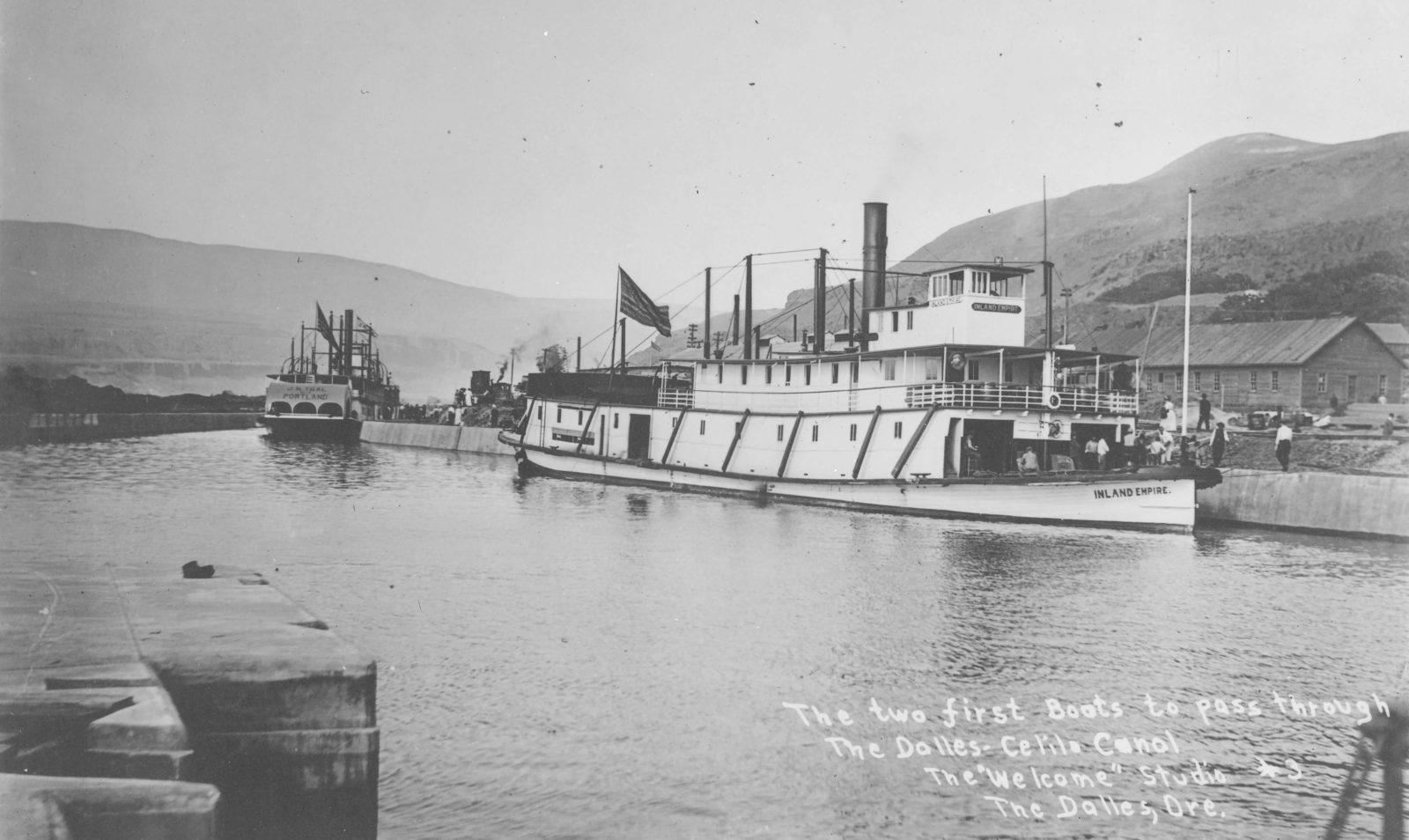
“It is not only opportune, but absolutely imperative that Kennewick should be awake and doing her share of this toiling, hoping, progressing. The first step to take is the creation of a port district.”
Kennewick Courier-Reporter Editorial, March 1915
The Port of Kennewick immediately began to operate docks, approach and landing facilities, leasing these facilities from the Kennewick Improvement Corporation (a private entity that had organized in 1909 to develop the facilities) for $1 per year. By the summer of 1915, shipments of cargo and passengers were leaving from and arriving at Kennewick’s docks.
In 1916, the Port held a public hearing and adopted its first Comprehensive Scheme document, which needed voter approval before any funding could be expended. Included in the Comprehensive Scheme were modest proposed improvements to the Ivy Street Terminal, a suggested concept to close off the upstream end of the channel between the shoreline and Clover Island, and dredging to create a boat basin. The comprehensive scheme was approved by a small majority (118 to 97), with some controversy regarding whether the public or private sector should be paying for proposed improvements.
The Port’s budget was $2,000 in 1916 and $1,800 in 1917. During this time, the Port constructed the Ivy Street Terminal for handling cargo and passengers, and also authorized the building of a new warehouse next to the waterfront to handle record-setting cargo volumes. In 1917, the Port purchased the previously leased land and assets from the Kennewick Improvement Corporation for $1,200. The following year, steamboat activities came to a halt due to rail competition and barges, which began replacing the less efficient steamboats.
The drop in steamboat traffic and rises in rail and motor vehicle traffic spurred the Port to refocus its activities. For the next several years, the Port concentrated on building rail- and water-transfer facilities and warehouses.
Celebration of Celilo Falls Canal opening in Kennewick
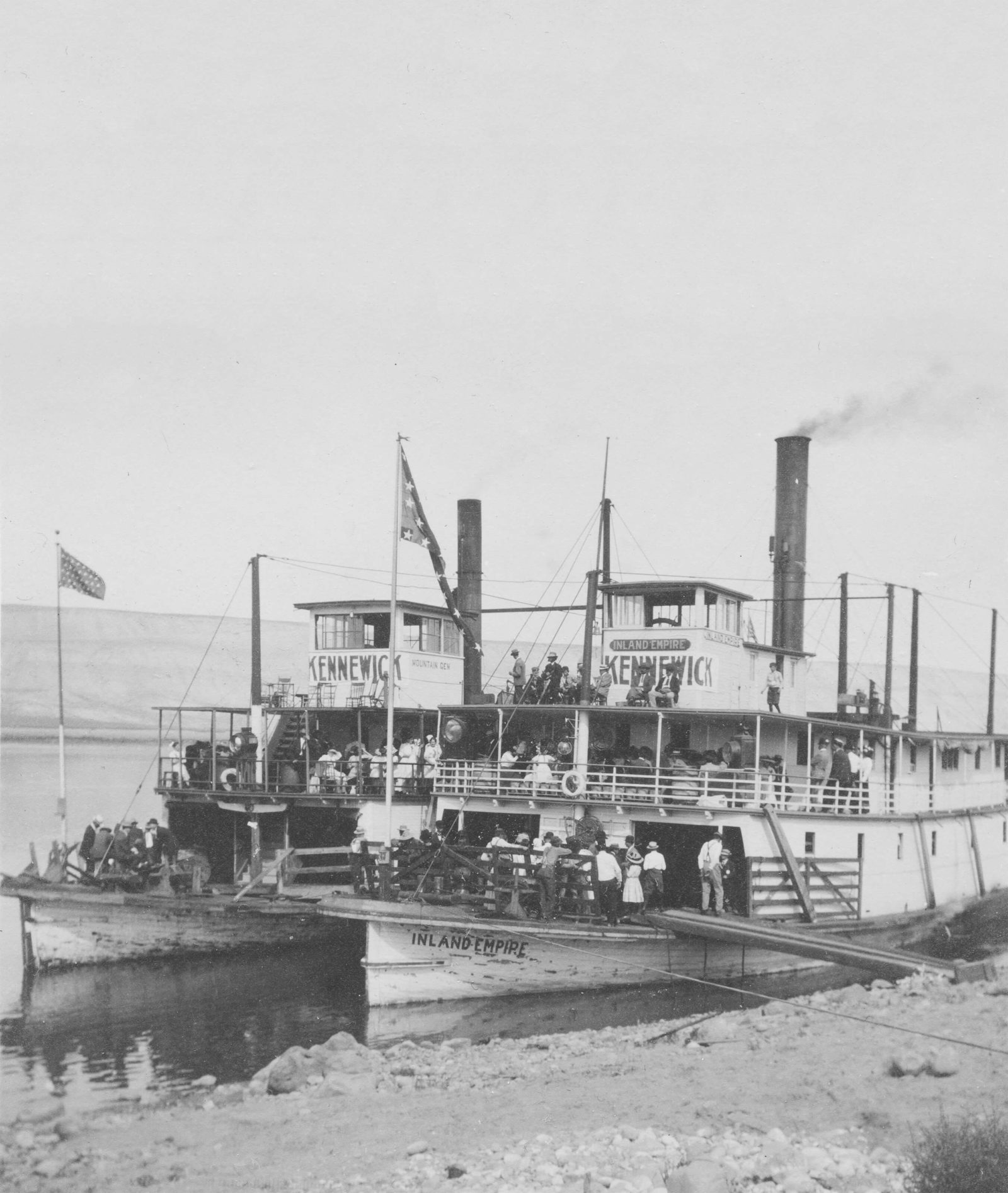
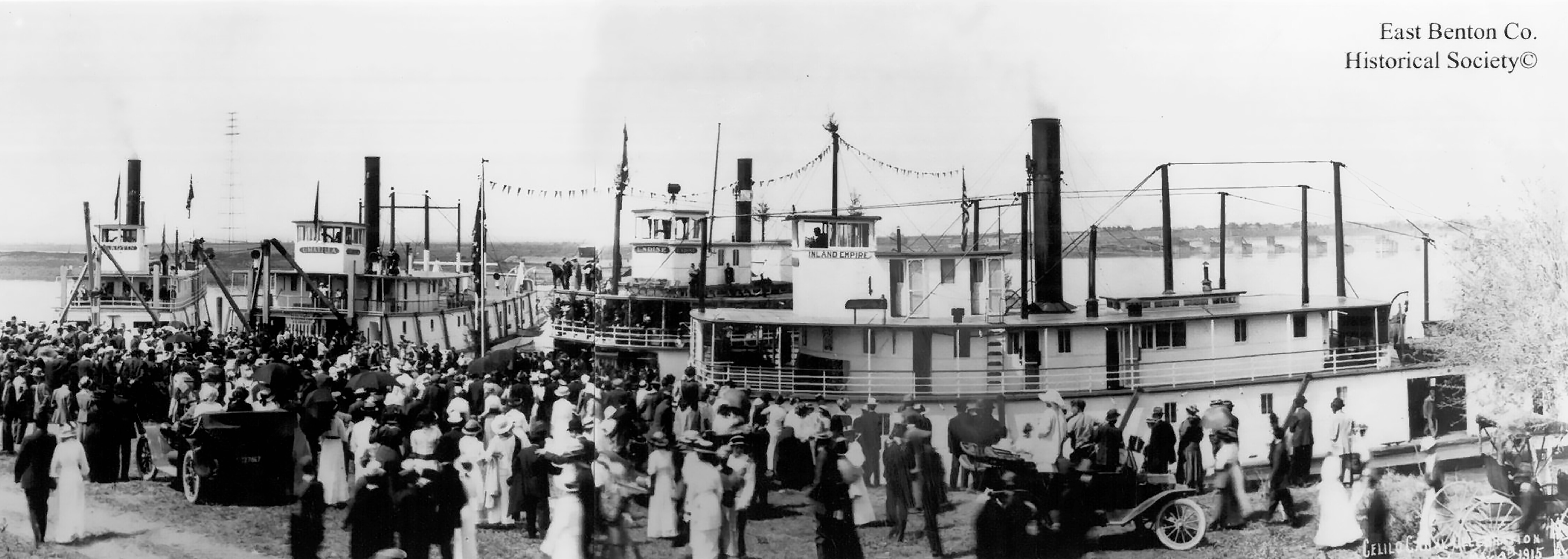
Docking and Loading Facilities for Boats and Barges
In the early 1900s, the Port of Kennewick provided docking and terminal facilities for steamboats, as a direct result of the opening of Celilo Falls navigation canal. The Inland Empire was one of the boats that traveled to Kennewick, where it served as a local ferry for several years, moving goods and people in and around the area from the Port’s docking and terminal facilities. A significant flood occurred in 1926 that severely damaged the Port’s dock and loading facilities, causing a period of Port inactivity until the 1940s.
In the early 1940s, World War II stimulated docking and loading activities in the Port. In 1941, the Port acquired a portion of Clover Island and leased property to Columbia Marine Shipyards for a barge-building site on the island. This barge-building site complemented the Port constructed bulk grain conveyor and elevator, and a dock extending more than 390 out into the Columbia River from the mainland just downstream of Clover Island.
- The Winquat, once considered the most powerful tugboat in the world, was built on Clover Island in 1944
- Port dock facility in 1922, just downstream of Clover Island
- Port of Kennewick Facilities Circa 1920
- Ivy Street Terminal (Port of Kennewick 1941)
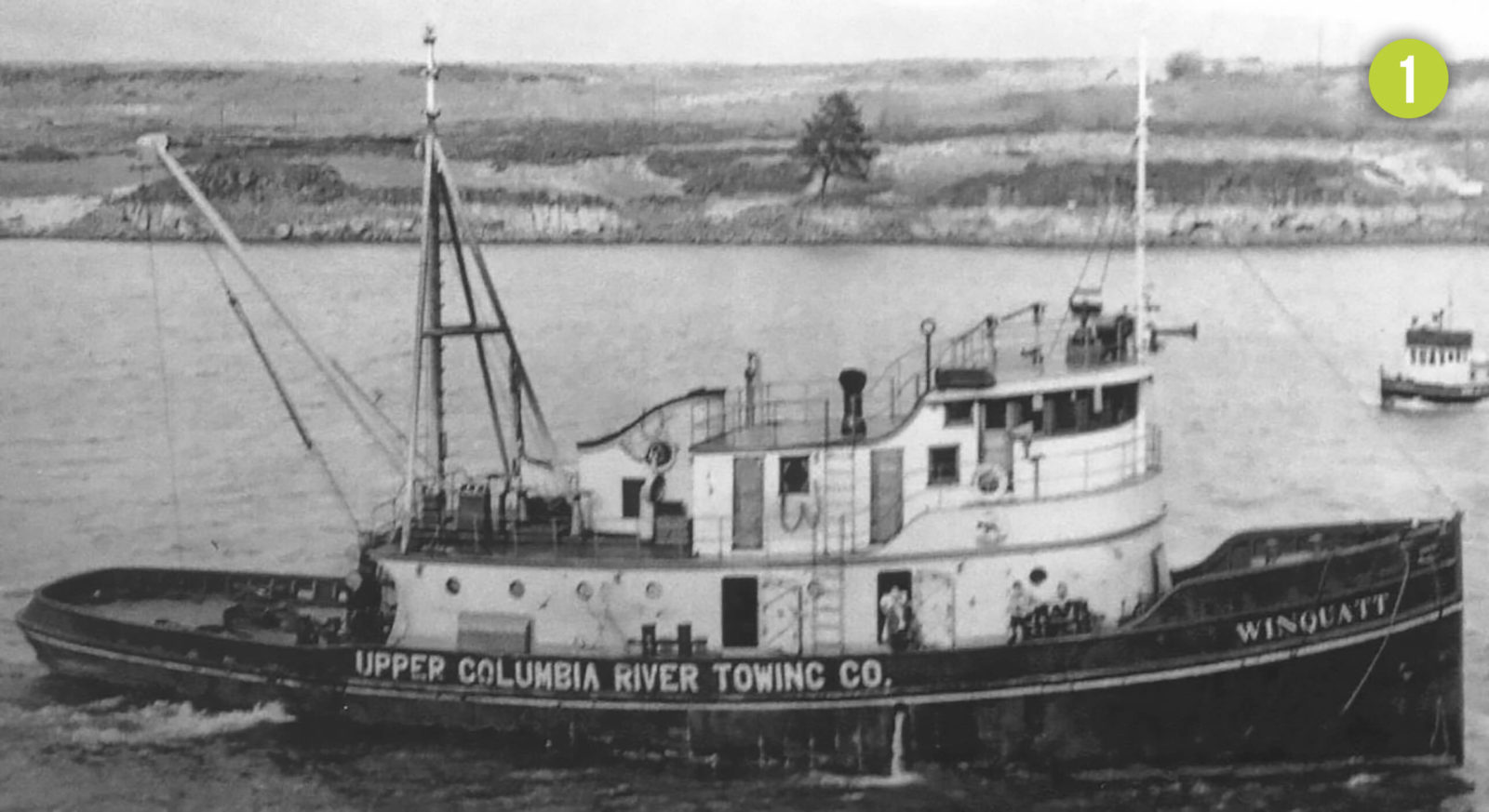
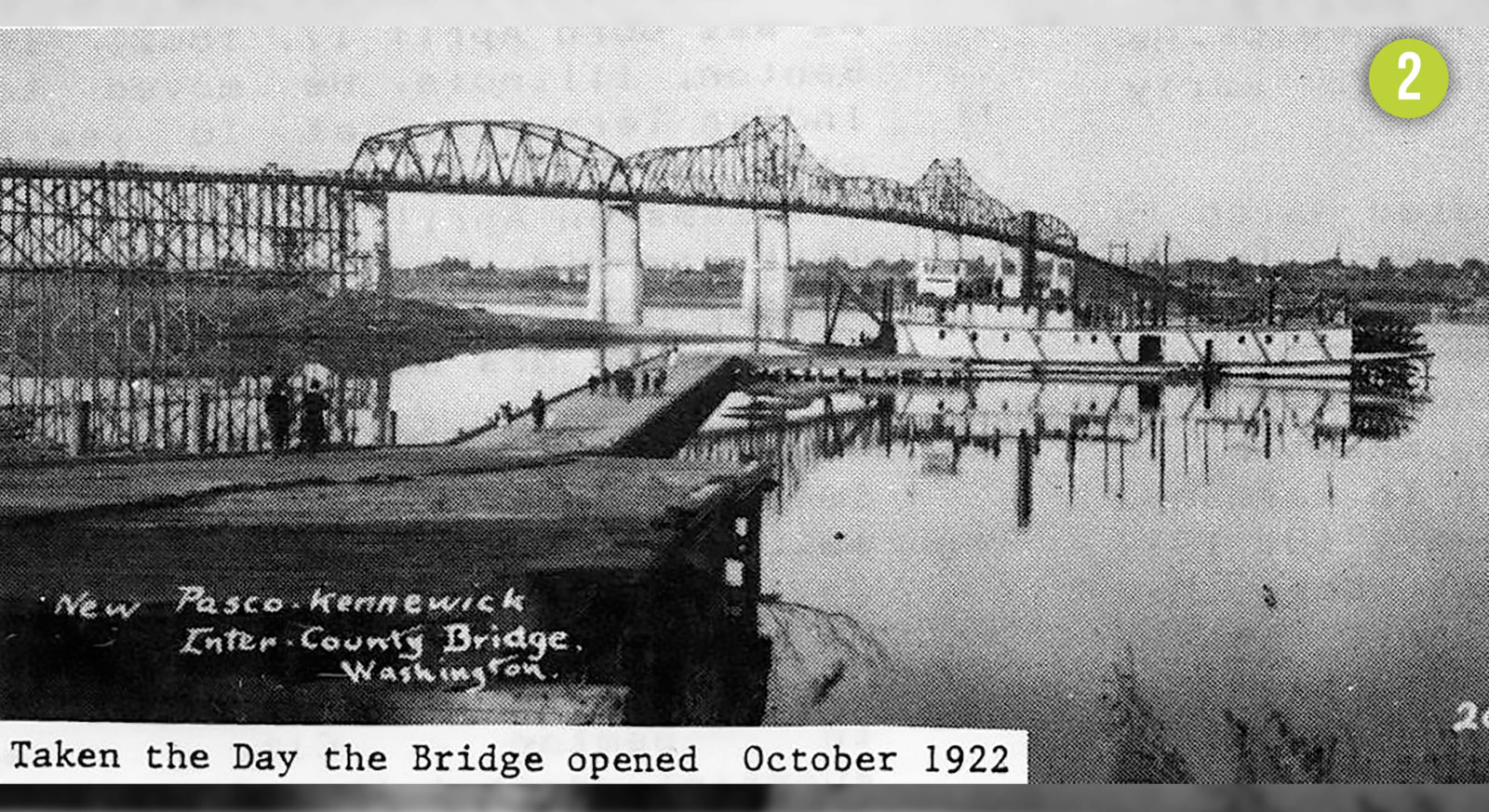
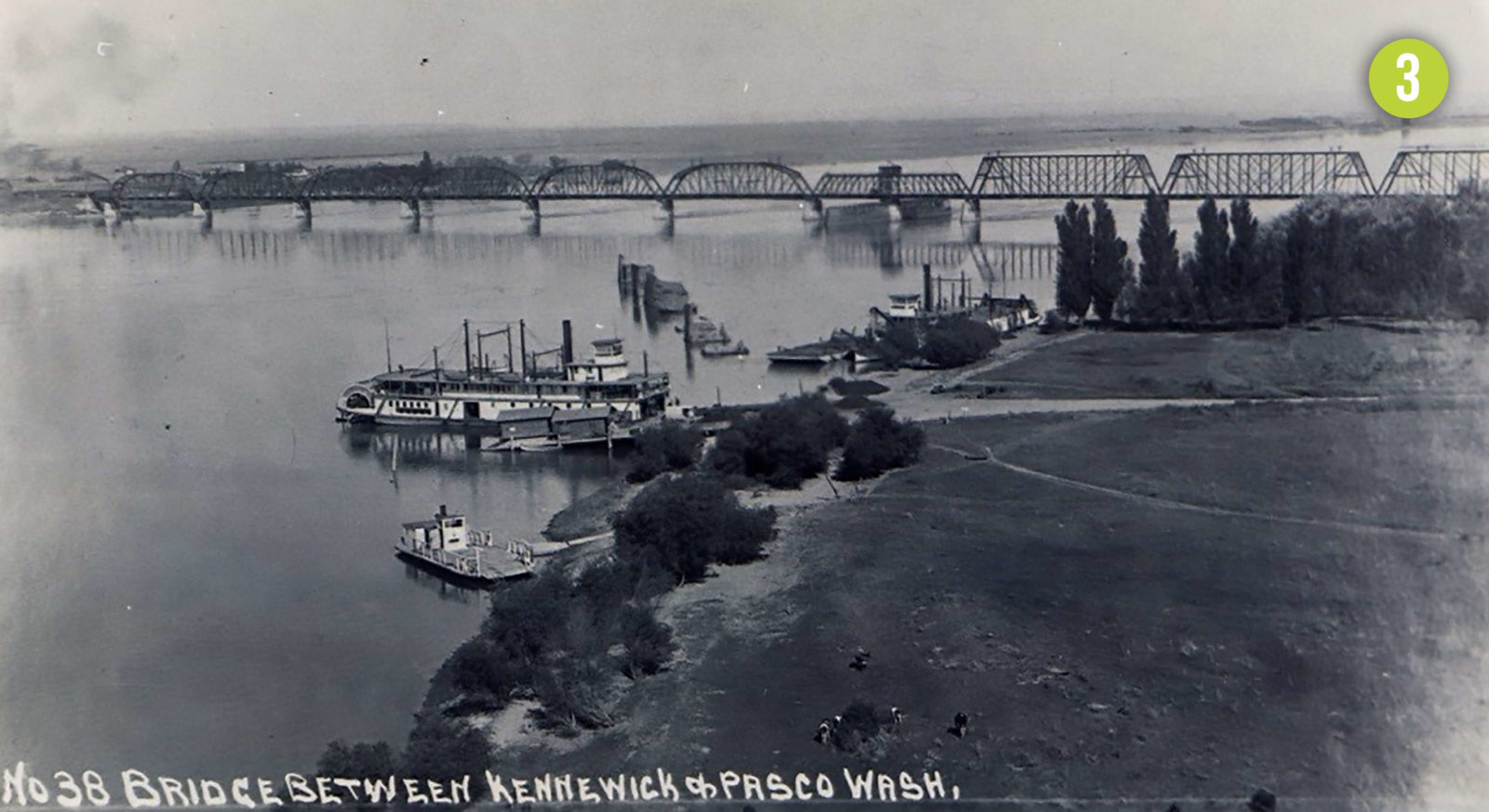
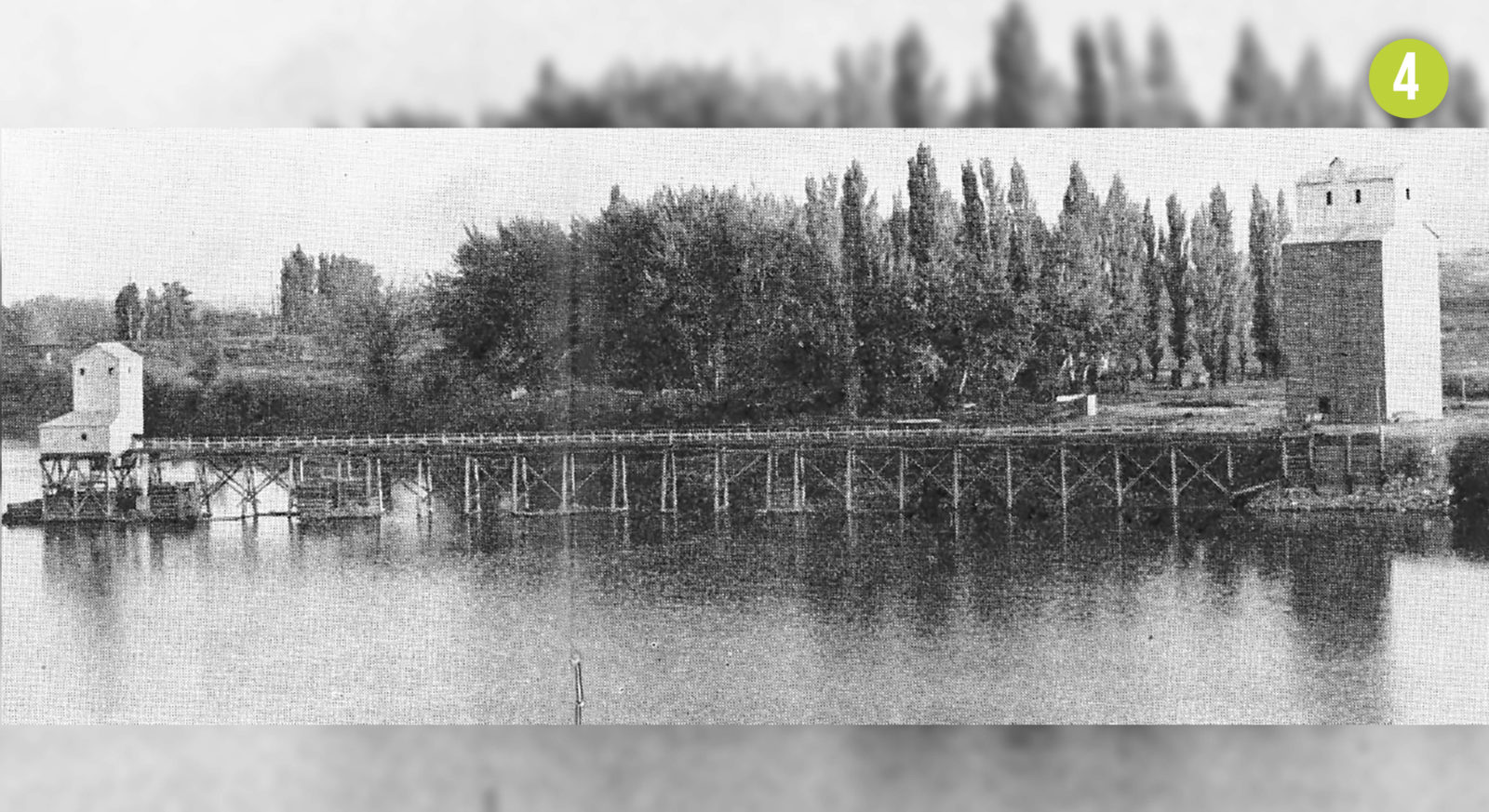
Two 175-foot barges were built and launched at Kennewick in the 1940s, and one was christened the Port of Kennewick. In 1944, the Winquatt, once known as the most powerful tugboat in the world, was also built at Clover Island.
Another large flood occurred in 1948 that caused significant damage to Port barge and boat loading facilities, and this ended the Port’s involvement in these type of facilities in the vicinity of Clover Island.
After the Port District boundary expanded in 1954, the Port constructed a dock and waterway at the Hedges Industrial Area in Finley to serve the chemical manufacturing businesses beginning to locate in that area. In 1967, the Port sold the Hedges land and presumably the associated water facilities to the Collier Carbon Chemical or other industrial businesses in the area, ending the Ports involvement in dock and barge loading facilities.
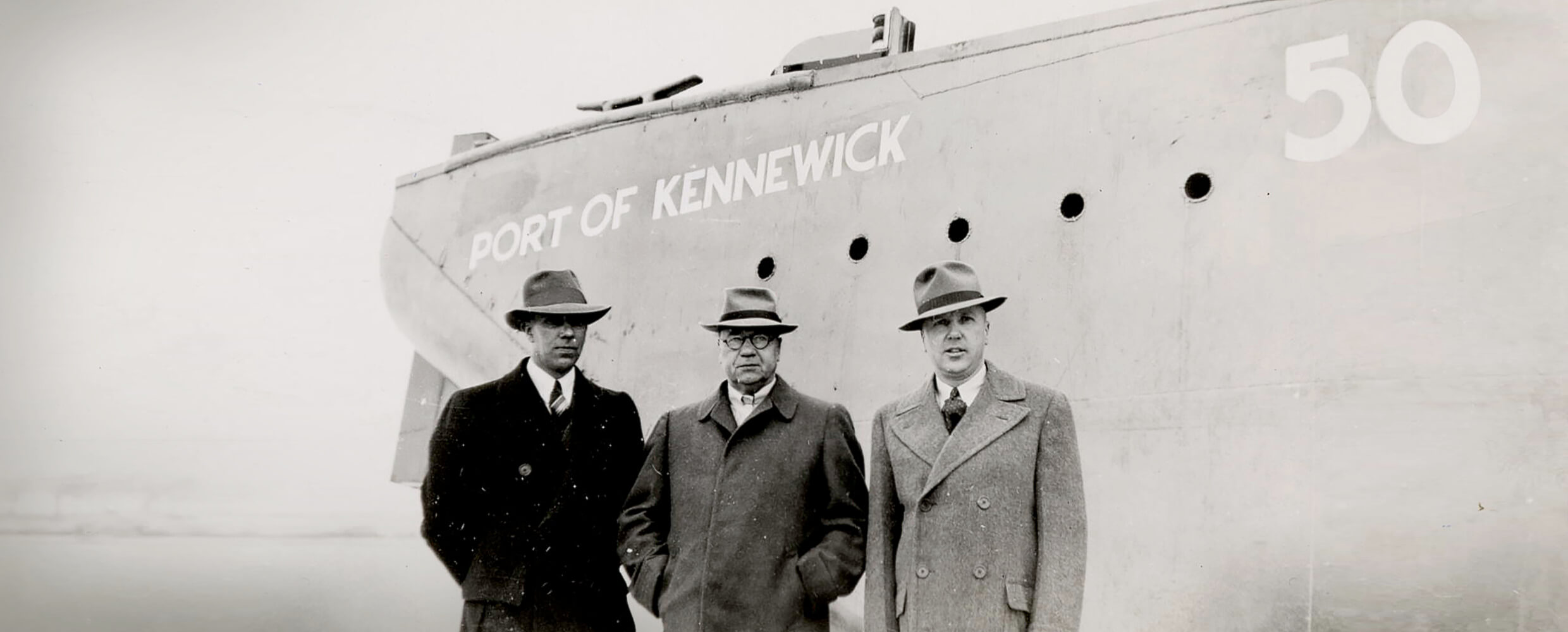
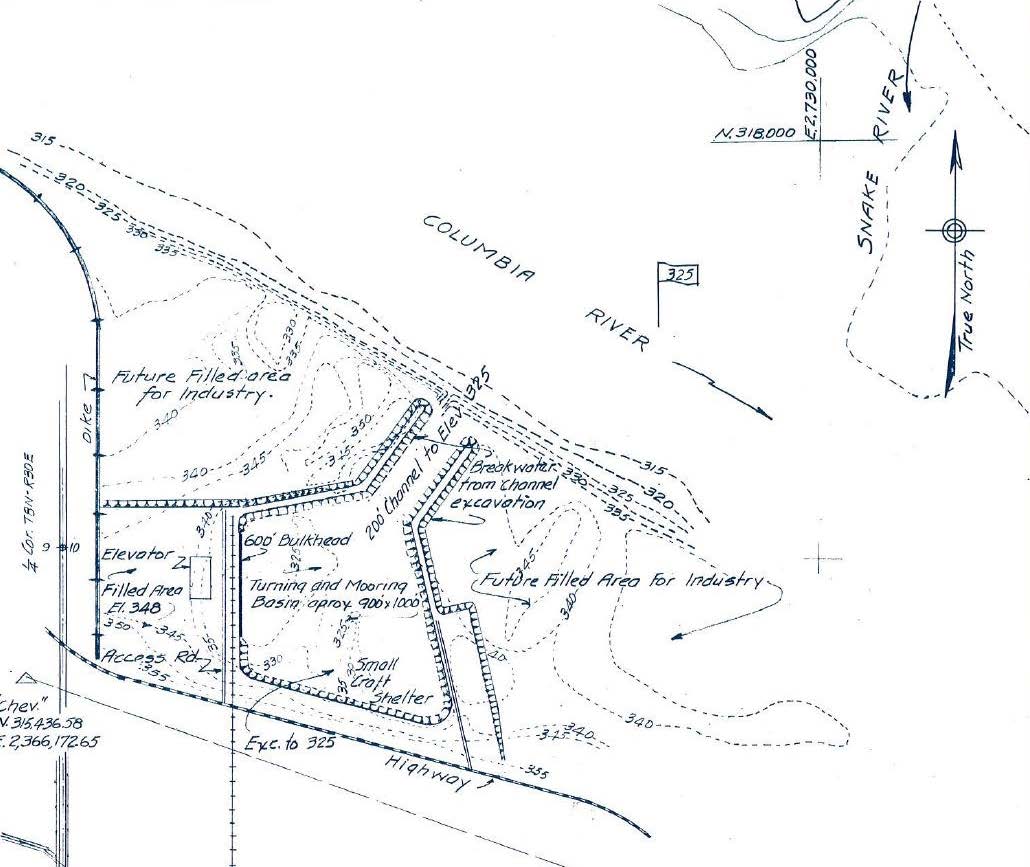
Top: Port Commissioners, A.I. Smith, George R. Turner, and Harry A. Linn attend the launch ceremony for a barge named Port of Kennewick, which was built on Clover Island.
Left: Schematic from 1955 Comprehensive Scheme for Development Plan illustrating Camp Two Rivers
Present-day Two Rivers Park was once identified as a Port industrial site for barge-loading facilities.
Historical and Current Port District Boundaries
The Port of Kennewick District boundary originally extended south from the Columbia River at the middle of the present-day Columbia Park Golf Course, to the intersection of US 395/10th Avenue, and then due east along 10th Avenue to the Columbia River. In 1954, after seven years of construction, the McNary Dam was finished, which provided flood control along the Columbia River and improved navigation to the Tri-Cities area.
The dam created new opportunities for the Port of Kennewick, with improved navigation and more river-accessible land in the City of Kennewick and Benton County. These opportunities led to an expansion of the Port District, additional Clover Island development, and heavy industrial development in the Finley and Hover areas of east Benton County. Property acquired by the U.S. Army Corps of Engineers and associated with McNary Dam construction was designated for industry, recreation, and habitat, and industrial land was made available to public agencies. This additional industrial land was made available to the Port, which led to a proposal to expand the Port District.
In November 1954, 75 percent of voters approved the expansion of the Kennewick Port District to include an area constituting 485 square miles and comprising the eastern half of Benton County.
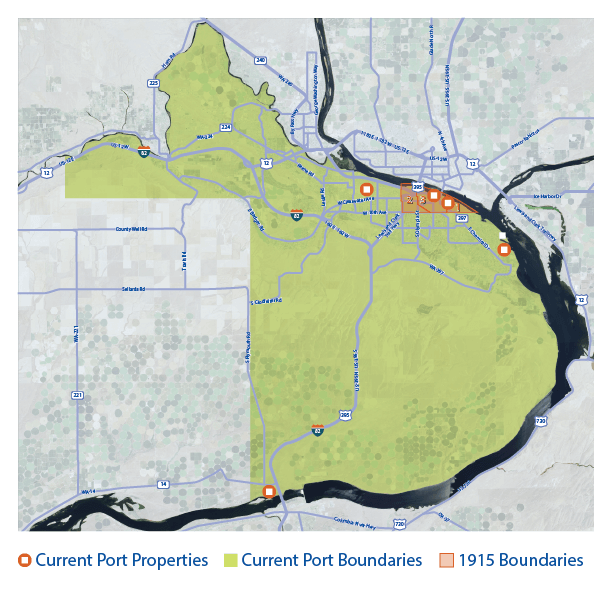
Port of Kennewick current boundaries
Port Supports the Navy During World War II and Later Invests in Rail in Downtown Kennewick
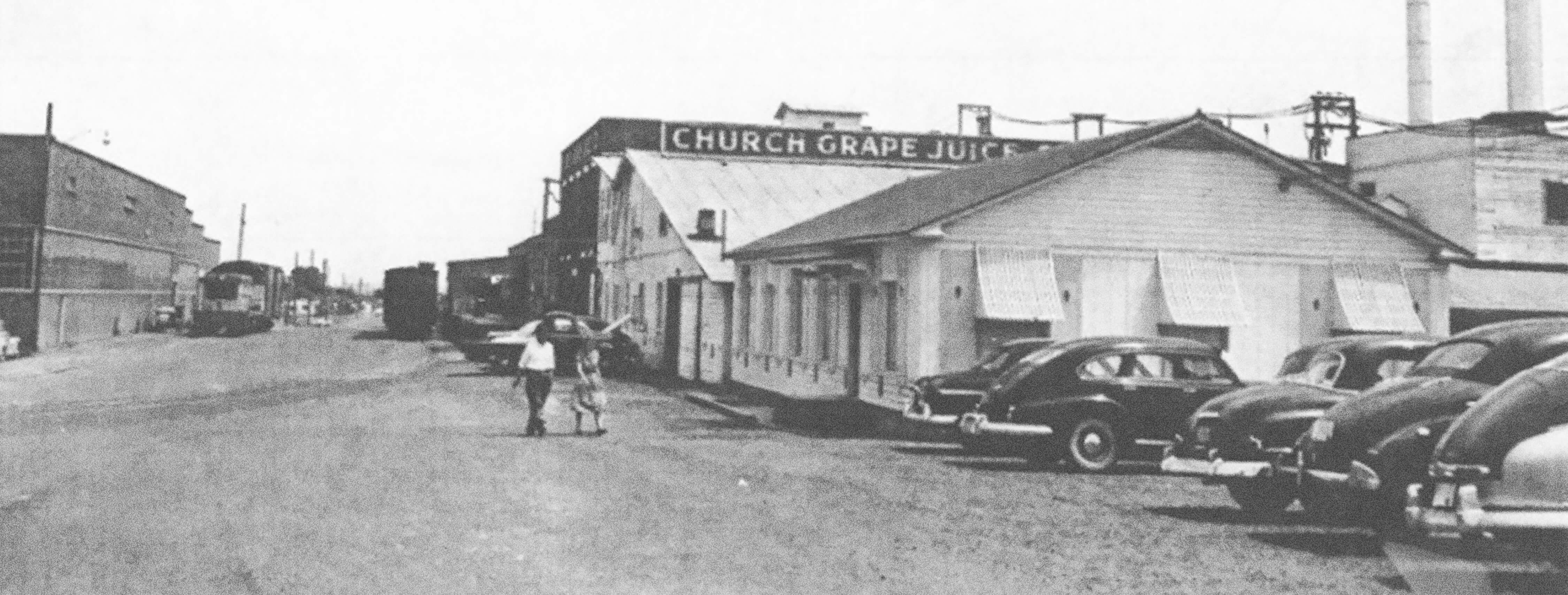
In 1942, representatives of the United States Navy called on the Port of Kennewick Commission to support the war effort by relinquishing to the Navy supplies of railroad steel and ties the Port had on hand for completion of a railroad spur track to Port facilities. The Port Commission felt duty-bound and obliged to the Navy’s request.
Rail was a primary means of moving products to and from the Port of Kennewick and other industrial properties in Kennewick during the 1940s. In 1941, Kennewick was served by three transcontinental railroads and originated thousands of railcars filled with frozen foods, canned goods, dressed poultry, asparagus, grape juice, cherries, and other commodities.
The Port had plans to develop additional rail spurs in the industrial areas of downtown Kennewick, but in 1942, the Port, in response to a request from the Navy, supported the war effort by donating steel and railroad ties.
Rail development plans were placed on hold until after the war, and the Port made substantial rail investments in downtown Kennewick during the 1950s.
1950s and 1960s Industrial Development (Chemical Row)
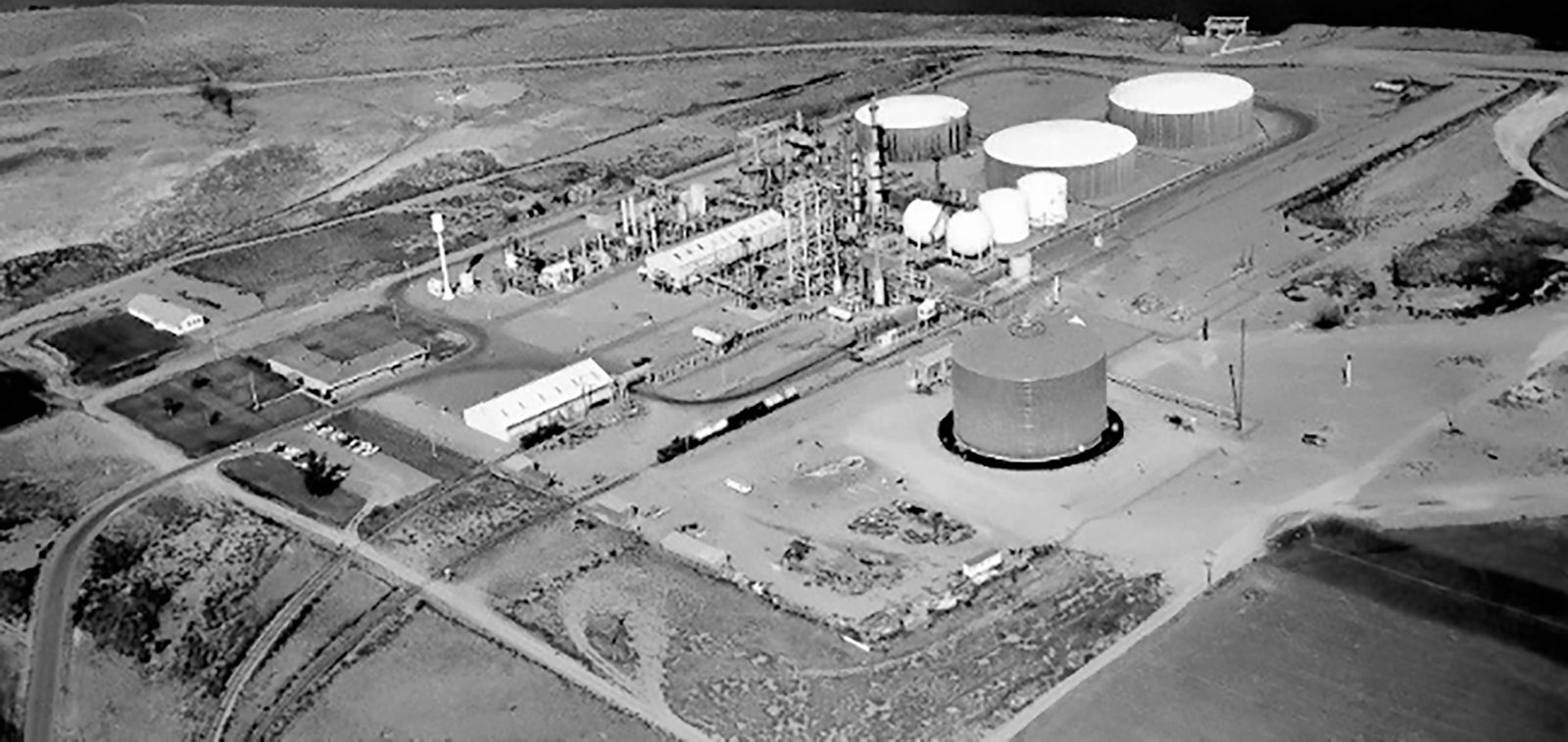
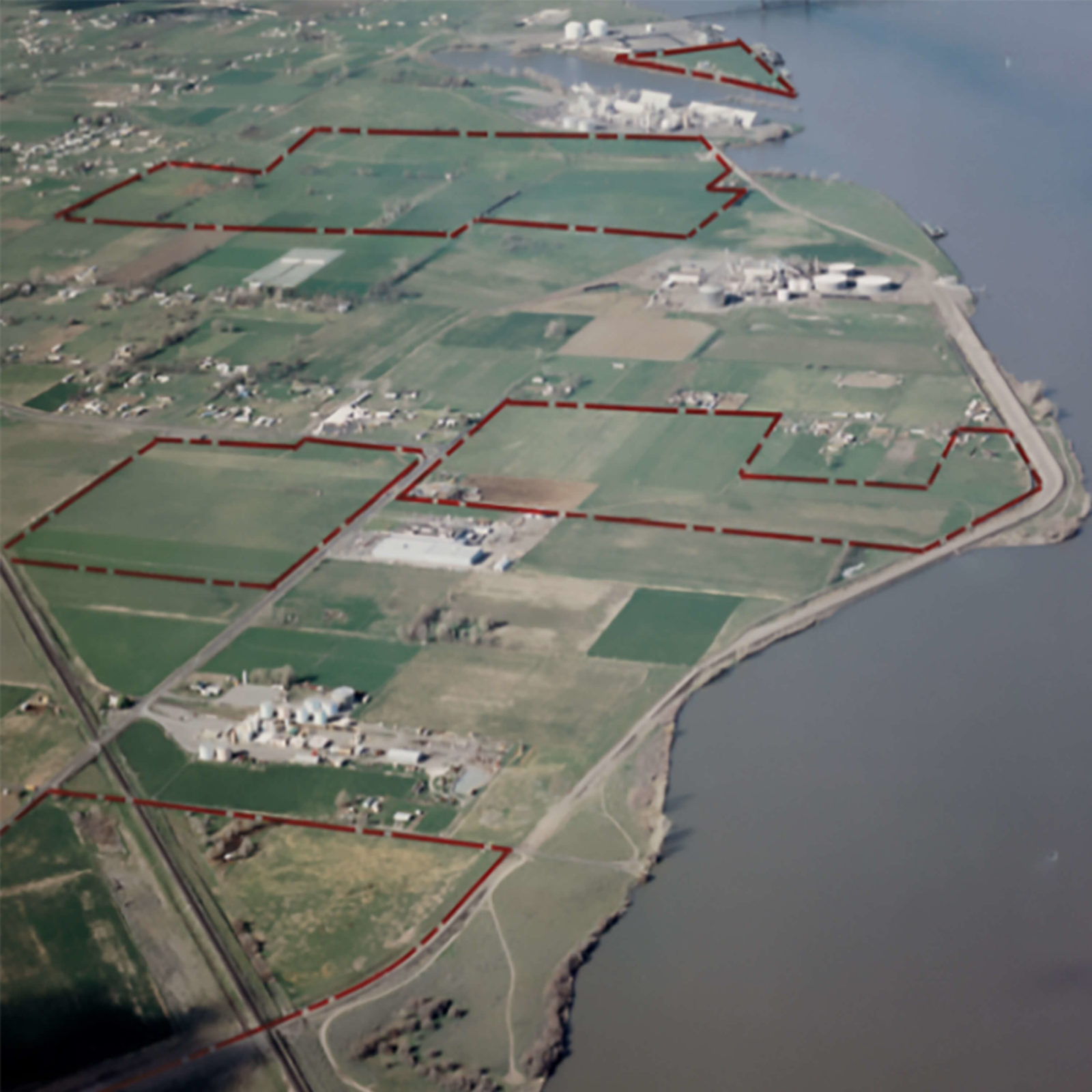
The Port acquired several industrial properties during the 1950s and 1960s in the Finley area. In 1956, after McNary Dam was constructed, the Port leased 314 acres of Columbia River waterfront land for development from the U.S. Army Corps of Engineers. Between 1953 and 1968, seven major firms established industrial operations in Finley, and the area became known as Chemical Row. These operations supported the U.S. Department of Energy Hanford Site Operations and produced fertilizer inputs to support the growing agricultural industry. A good example of this development occurred in 1957 when the Phillips Pacific Chemical Company built a $15-million plant to produce anhydrous ammonia. The plant employed nearly 100 people and was considered the area’s largest private industrial development at the time.
The Chemical Row area was known for its central location, ample transportation, low-cost power, and plentiful water. Total private investment in the Finley area from 1952 to 1964 exceeded $23 million and resulted in approximately 250 new jobs. Most of these plants are still in operation today. Sandvik Special Metals also located in the Finley area and is currently a thriving business.
The Collier Carbon and Chemical Corporation bought a 40-acre site from the Port of Kennewick for $140,000 at the present-day Hedges Industrial Area (now owned by Agrium), and the plant was finished in 1967.
1953 to 1968
Chemical Row Finley Area
1953 Allied Chemical (now abandoned)
1957 Kerley Chemical
1957 Phillips Pacific Chemical (now Agrium)
1958 Gas Ice (now Air Liquide)
1960 Cal-Spray Chemical (now Agrium)
1967 Collier Carbon and Chemical Corporation (now Agrium)
1968 Sandvik Special Metals
City of Kennewick Water-Supply Facilities on Clover Island
The City of Kennewick had water supply facilities on Clover Island from the 1950s through 1980. The first system was a filter bed in the “notch” area of the island, with pump stations just upstream, which were installed in 1952. This system only lasted a few years before failing. Then, in the late 1950s, the City installed three Ranney Well collectors housed in round, concrete structures. These were located on the northern side (river side) of the island. In 2002, two of the three Ranney well pumps were removed and the collectors were leveled and capped with concrete slabs. Safety railings were added, turning the slabs into viewing platforms.
City of Kennewick Ranney Well collector on Clover Island originally and then converted to a viewing platform
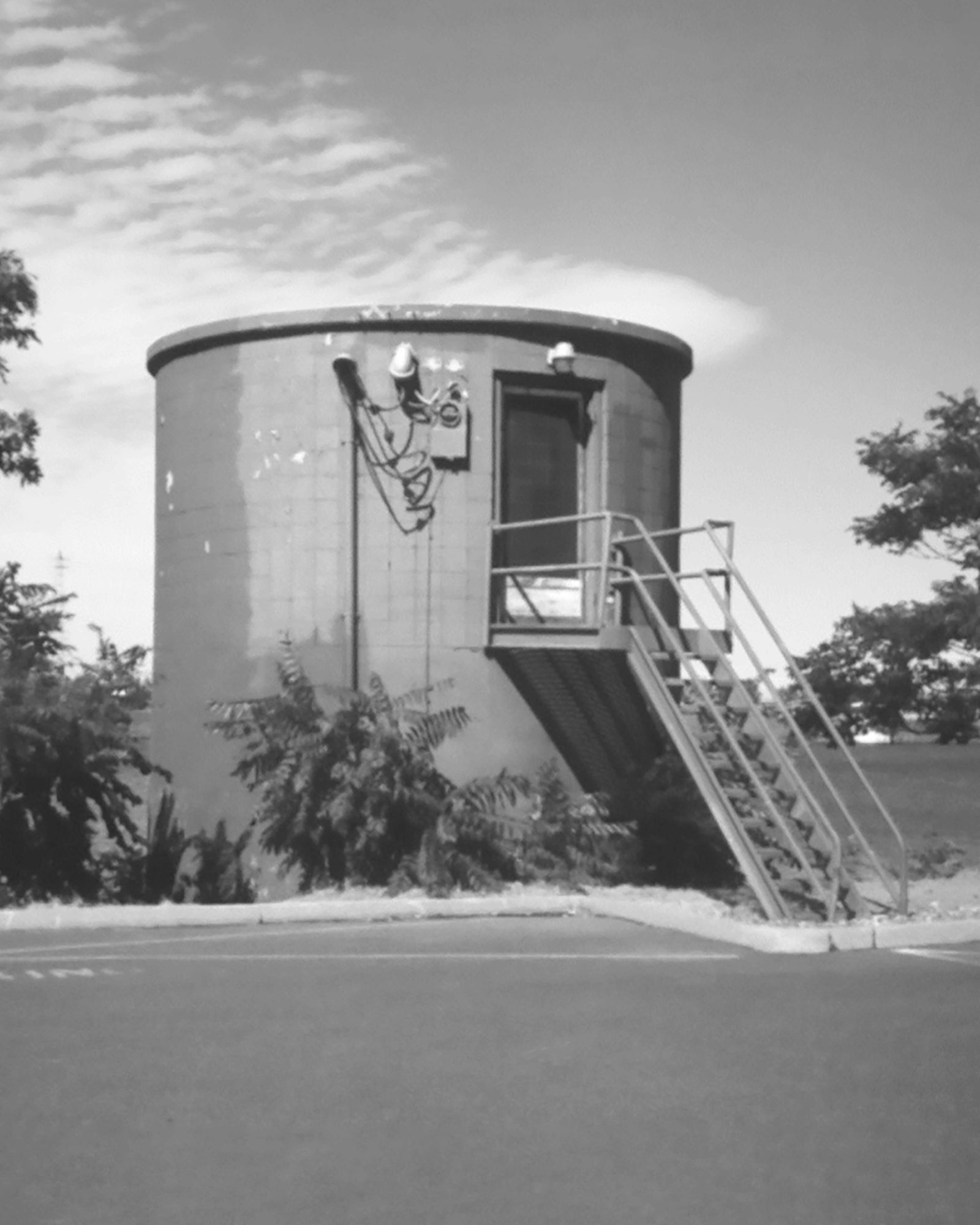
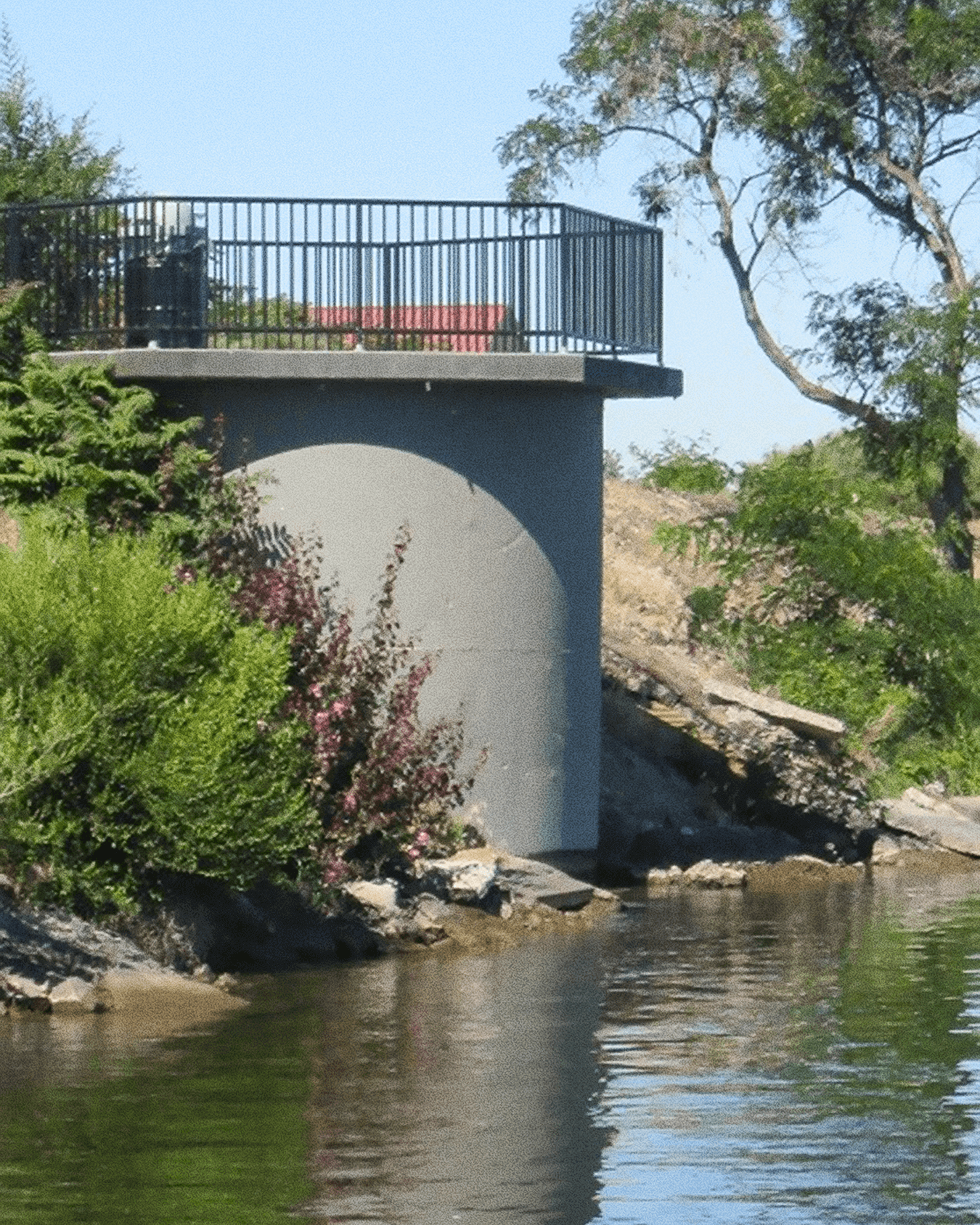
Port Commissioners & Executive Directors
During the last 100 years, 36 Commissioners represented the Port of Kennewick, with Gene Spaulding having the longest tenure (36 years, from 1963 to 1998). James E. Magnuson served as a Port Commissioner for 21 years—serving from 1953 to 1973. Of the remaining Commissioners, six served more than ten years, including A. I. Smith (1931 to 1942), Paul G. Richmond (1943 to 1954), Ray F. Hamilton (1955 to 1966), Dave Dickerson (1977 to 1991), George Jones (1986 to 1997), and Gene Wagner (2002 to 2013).
The very first Commissioners
G. M. Annis, 1915 to 1916
M. H. Church, 1915 to 1924
W. R. Weisel, 1915 to 1923
Other Commissioners included:
Ingwall Smith, 1917 to 1924
G.R. Bradshaw, 1924 to 1931
Willard Campbell, 1931 to 1939
Jay Perry, 1931 to 1939
George R. Turner, 1940 to 1942
Harry A. Linn, 1940 to 1942
Ralph E. Reed, 1943 to 1944
Alfred C. Amon, 1945 to 1952
Walter M. Knowles, 1945 to 1952
Edward H. Weber, 1953 to 1956
John H. Grigg, 1957 to 1962
Wayne L. Rogers 1967 to 1973
Charles F. Markham, 1974 to 1976
Gilbert J. Ackerman, 1974 to 1978
Ray L. Elmgren, 1979 to 1985
Paul L. Vick, 1992 to 2001
Sue Frost, 1998 to 2002
Norm Engelhard, 1999 to 2001
John Olson, 2000 to 2005
Dave Hanson, 2003 to 2012
Linda Boomer, 2006 to 2008
Calvin Dudney, 2008 to 2009
Gene Wagner, 2002 to 2013
Don Barnes, 2012 to 2021
Current Board of Commissioners:
Skip Novakovich, 2009 to present
Kenneth Hohenberg, 2022 to present
Thomas Moak, 2014 to present
Port Executive Directors
John Neuman, 1955 to 1973
Robert “Hank” Thietje, 1974 to 1976
Art Colby, 1974 to 1979
Sue Watkins (Frost), 1979 to 1997
John Givens, 1997 to 2004
Tim Arntzen, 2004 to present